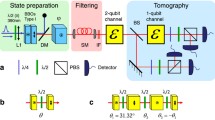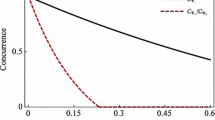Abstract
We calculate the two-qubit disentanglement due to classical random telegraph noise using the quasi-Hamiltonian method. This allows us to obtain analytical results even for strong coupling and mixed noise, important when the qubits have tunable working point. We determine when entanglement sudden death and revival occur as functions of qubit working point, noise coupling strength and initial state entanglement. For extended Werner states, we show that the concurrence is related to the difference of two functions: one is related to dephasing and the other longitudinal relaxation. A physical interpretation based on the generalized Bloch vector is given: revival only occurs for strongly-coupled noise and comes from the angular motion of the vector.
Similar content being viewed by others
References
Horodecki R., Horodecki P., Horodecki M., Horodecki K.: Quantum entanglement. Rev. Mod. Phys. 81, 865–942 (2009)
Gisin N., Ribordy G., Tittel W., Zbinden H.: Quantum cryptography. Rev. Mod. Phys. 74, 145–195 (2002)
Bennett C.H., Wiesner S.J.: Communication via one- and two-particle operators on Einstein-Podolsky-Rosen states. Phys. Rev. Lett. 69, 2881–2884 (1992)
Bennett C.H., Brassard G., Crépeau C., Jozsa R., Peres A., Wooters W.K.: Teleporting an unknown quantum state via dual classical and Einstein-Podolsky-Rosen channels. Phys. Rev. Lett. 70, 1895–1899 (1993)
Shor P.W.: Polynomial-time algorithms for prime factorization and discrete logarithms on a quantum computer. SIAM J. Comp. 26, 1484–1509 (1997)
Grover L.K.: Quantum mechanics helps in searching for a needle in a haystack. Phys. Rev. Lett. 79, 325–328 (1997)
Yu T., Eberly J.H.: Sudden death of entanglement. Science 323, 598–601 (2009)
Almeida M.P., de Melo F., Hor-Meyll M., Salles A., Walborn S.P., Souto Ribeiro P.H., Davidovich L.: Environment-induced sudden death of entanglement. Science 316, 579–582 (2007)
Laurat J., Choi K.S., Deng H., Chou C.W., Kimble H.J.: Heralded entanglement between atomic ensembles: preparation, decoherence, and scaling. Phys. Rev. Lett. 99, 180504 (2007)
Yu T., Eberly J.H.: Finite-time disentanglement via spontaneous emission. Phys. Rev. Lett. 9 3, 140404 (2004)
Yu T., Eberly J.H.: Quantum open system theory: bipartite aspects. Phys. Rev. Lett. 97, 140403 (2006)
Yu T., Eberly J.H.: Sudden death of entanglement: classical noise effects. Opt. Commun. 264, 393–397 (2006)
Santos M.F., Milman P., Davidovich L., Zagury N.: Direct measurement of finite-time disentanglement induced by a reservoir. Phys. Rev. A 73, 040305(R) (2006)
Ficek Z., Tanaś R.: Dark periods and revivals of entanglement in a two-qubit system. Phys. Rev. A 74, 024304 (2006)
Kogan S.: Electronic Noise and Fluctuations in Solids. Cambridge University Press, Cambridge (1996)
Weissman M.B.: 1/f Noise and other slow, nonexponential kinetics in condensed matter. Rev. Mod. Phys. 60, 537–571 (1988)
Dutta P., Horn P.M.: Low-frequency fluctuations in solids: 1/f noise. Rev. Mod. Phys. 53, 497–516 (1981)
Yoshihara F., Harrabi K., Niskanen A.O., Nakamura Y., Tsai J.S.: Decoherence of flux qubits due to 1/f flux noise. Phys. Rev. Lett. 97, 167001 (2006)
Kakuyanagi K., Meno T., Saito S., Nakano H., Semba K., Takayanagi H., Deppe F., Shnirman A.: Dephasing of a superconducting flux qubit. Phys. Rev. Lett. 98, 047004 (2007)
Nakamura Y., Pashkin Y.A., Yamamoto T., Tsai J.S.: Charge echo in a Cooper-pair box. Phys. Rev. Lett. 88, 047901 (2002)
Wellstood F.C., Urbina C., Clarke J.: Low-frequency noise in dc superconducting quantum interference devices below 1 k. Appl. Phys. Lett. 50, 772–774 (1987)
Bialczak R.C., McDermott R., Ansmann M., Hofheinz M., Katz N., Lucero E., Neeley M., O’Connell A.D., Wang H., Cleland A.N., Martinis J.M.: 1/f Flux noise in Josephson phase qubits. Phys. Rev. Lett. 99, 187006 (2007)
Van Harlingen D.J., Robertson T.L., Plourde B.L.T., Reichardt P.A., Crane T.A., Clarke J.: Decoherence in Josephson-junction qubits due to critical-current fluctuations. Phys. Rev. B 70, 064517 (2004)
Khaetskii A.V., Loss D., Glazman L.: Electron spin decoherence in quantum dots due to interaction with nuclei. Phys. Rev. Lett. 88, 186802 (2002)
Bellomo B., Lo Franco R., Compagno G.: Non-Markovian effects on the dynamics of entanglement. Phys. Rev. Lett. 99, 160502 (2007)
Bellomo B., Lo Franco R., Compagno G.: Entanglement dynamics of two independent qubits in environments with and without memory. Phys. Rev. A 77, 032342 (2008)
Dajka J., Mierzejewski M., Luczka J.: Non-Markovian entanglement evolution of two uncoupled qubits. Phys. Rev. A 77, 042316 (2008)
Mazzola L., Maniscalco S., Piilo J., Suominen K.-A., Garraway B.M.: Sudden death and sudden birth of entanglement in common structured reservoirs. Phys. Rev. A 79, 042302 (2009)
Yu T., Eberly J.H.: Entanglement evolution in a non-Markovian environment. Opt. Commun. 283, 676–680 (2010)
Testolin M.J., Cole J.H., Hollenberg L.C.L.: Modeling two-spin dynamics in a noisy environment. Phys. Rev. A 40, 042326 (2009)
Yu T., Eberly J.H.: Phonon decoherence of quantum entanglement: robust and fragile states. Phys. Rev. B 66, 193306 (2002)
Roszak K., Machnikowski P.: Complete disentanglement by partial pure dephasing. Phys. Rev. A 73, 022313 (2006)
Ann K., Jaeger G.: Disentanglement and decoherence in two-spin and three-spin systems under dephasing. Phys. Rev. B 75, 115307 (2007)
Cao X., Zheng H.: Non-Markovian disentanglement dynamics of a two-qubit system. Phys. Rev. A 77, 022320 (2008)
Cheng B., Wang Q.H., Joynt R.: Transfer matrix solution of a model of qubit decoherence due to telegraph noise. Phys. Rev. A 78, 022313 (2008)
Joynt, R., Zhou, D., Wang, Q.H.: Quasi-Hamiltonian method for computation of decoherence rates arXiv:0906.2843 (2009)
Zhou D., Joynt R.: Noise-induced looping on the Bloch sphere: oscillatory effects in dephasing of qubits subject to broad-spectrum noise. Phys. Rev. A 81, 010103(R) (2010)
Galperin Y.M., Altshuler B.L., Bergli J., Shantsev D.V.: Non-Gaussian low-frequency noise as a source of qubit decoherence. Phys. Rev. Lett. 96, 097009 (2006)
Galperin Y.M., Altshuler B.L., Bergli J., Shantsev D., Vinokur V.: Non-Gaussian dephasing in flux qubits due to 1/f noise. Phys. Rev. B 76, 064531 (2007)
Paladino E., Faoro L., Falci G., Fazio R.: Decoherence and 1/f noise in Josephson qubits. Phys. Rev. Lett. 88, 228304 (2002)
Falci G., D’Arrigo A., Mastellone A., Paladino E.: Initial decoherence in solid state qubits. Phys. Rev. Lett. 94, 167002 (2005)
Byrd M.S., Khaneja N.: Characterization of the positivity of the density matrix in terms of the coherence vector representation. Phys. Rev. A. 68, 062322 (2003) note our normalization of the Bloch vector differs from this reference
Braun D.: Creation of entanglement by interaction with a common heat bath. Phys. Rev. Lett. 89, 277901 (2002)
Kim M.S., Lee J., Ahn D., Knight P.L.: Entanglement induced by a single-mode heat environment. Phys. Rev. A 65, 040101(R) (2002)
Paz J.P., Roncaglia A.J.: Dynamics of the entanglement between two oscillators in the same environment. Phys. Rev. Lett. 100, 220401 (2008)
Slichter C.P.: Principles of Magnetic Resonance. 3rd edn. Springer, New York (1996)
Wootters W.K.: Entanglement of formation of an arbitrary state of two qubits. Phys. Rev. Lett. 80, 2245–2248 (1998)
Werner R.F.: Quantum states with Einstein-Podolsky-Rosen correlations admitting a hidden-variable model. Phys. Rev. A 40, 4277–4281 (1989)
Bertlmann, R.A., Krammer, P.: arXiv:0706.1743 (2007)
Braunstein S.L., Caves C.M., Jozsa R., Linden N., Popescu S., Schack R.: Separability of very noisy mixed states and implications for NMR quantum computing. Phys. Rev. Lett. 83, 1054–1057 (1999)
Dür W., Cirac J.I., Tarrach R.: Separability and distillability of multiparticle quantum systems. Phys. Rev. Lett. 83, 3562–3565 (1999)
Gurvits L., Barnum H.: Separable balls around the maximally mixed multipartite quantum states. Phys. Rev. A 68, 042312 (2003)
Gurvits L., Barnum H.: Better bound on the exponent of the radius of the multipartite separable ball. Phys. Rev. A 72, 032322 (2005)
Maniscalco S., Francica F., Zaffino R.L., Lo Gullo N., Plastina F.: Protecting entanglement via the quantum Zeno effect. Phys. Rev. Lett. 100, 090503 (2008)
Author information
Authors and Affiliations
Corresponding author
Rights and permissions
About this article
Cite this article
Zhou, D., Lang, A. & Joynt, R. Disentanglement and decoherence from classical non-Markovian noise: random telegraph noise. Quantum Inf Process 9, 727–747 (2010). https://doi.org/10.1007/s11128-010-0165-2
Received:
Accepted:
Published:
Issue Date:
DOI: https://doi.org/10.1007/s11128-010-0165-2




